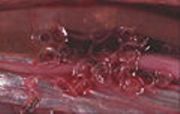Anisakis simplex
A Marine Parasite
Disease and Treatment
Anisakis simplex, simply through its parasitic life style, is responsible for possible pathology in its hosts. In its marine hosts, it largely causes nutritional issues. However, when ingested by humans, who become its third and accidental host, it can have a much more profound effect.
Disease
When humans consume Anisakis simplex,
which occurs largely through eating raw or undercooked
seafood, the parasite is still in its
third larval stage.
This is the infective stage which is the causal agent of anisakiasis. The organism makes its home in
the intestines of the human host, burrowing into the mucosa.
Anywhere between an hour and two weeks later, the presence
of the parasite can be diagnosed in one of two ways; either
the worm can become dislodged and subsequently coughed up by
the host, or abdominal discomfort will notify the host of
its presence. The accompanying symptoms of infection are
nausea and acute pain in the gastrointestinal tract.

The main mechanism triggered by the parasite that causes this sort of reaction is an eosinophilic immune response. The parasite, as it attempts to lodge itself within the organism, secretes biochemical substances that are foreign to the hosts immune system, causing the migration of eosinophils and other white blood cells to the site. They attempt to form a granuloma around the organism, to sequester it in the tissues. However, this immune response is largely responsible for the inflammation and subsequent discomfort felt by the human host.
Another possible pathology can occur when the human host has immunoglobin E sensitivities. This pathology is a severe anaphylactic reaction produced in reaction to the biochemical secretions of either the living Anisakis simplex or secretions left by it in the consumed marine host.
Treatment
Once Anisakis simplex is detected, it can be treated by a variety of methods. One possible method is simply waiting. When the organism develops into its adult form within the host, it will likely not withstand the conditions of the human body, and thus will be eliminated naturally. Another method, and the most common method due to the amount of discomfort, is surgical removal of the infecting parasites. Pharmaceutical treatment is also used. Albendazole, a common antiparasitic, has been used successfully in some cases. In cases of allergic reactions, anaphylaxis must first be treated and, if the parasite is still present within the human host, it must be removed. Back to Home